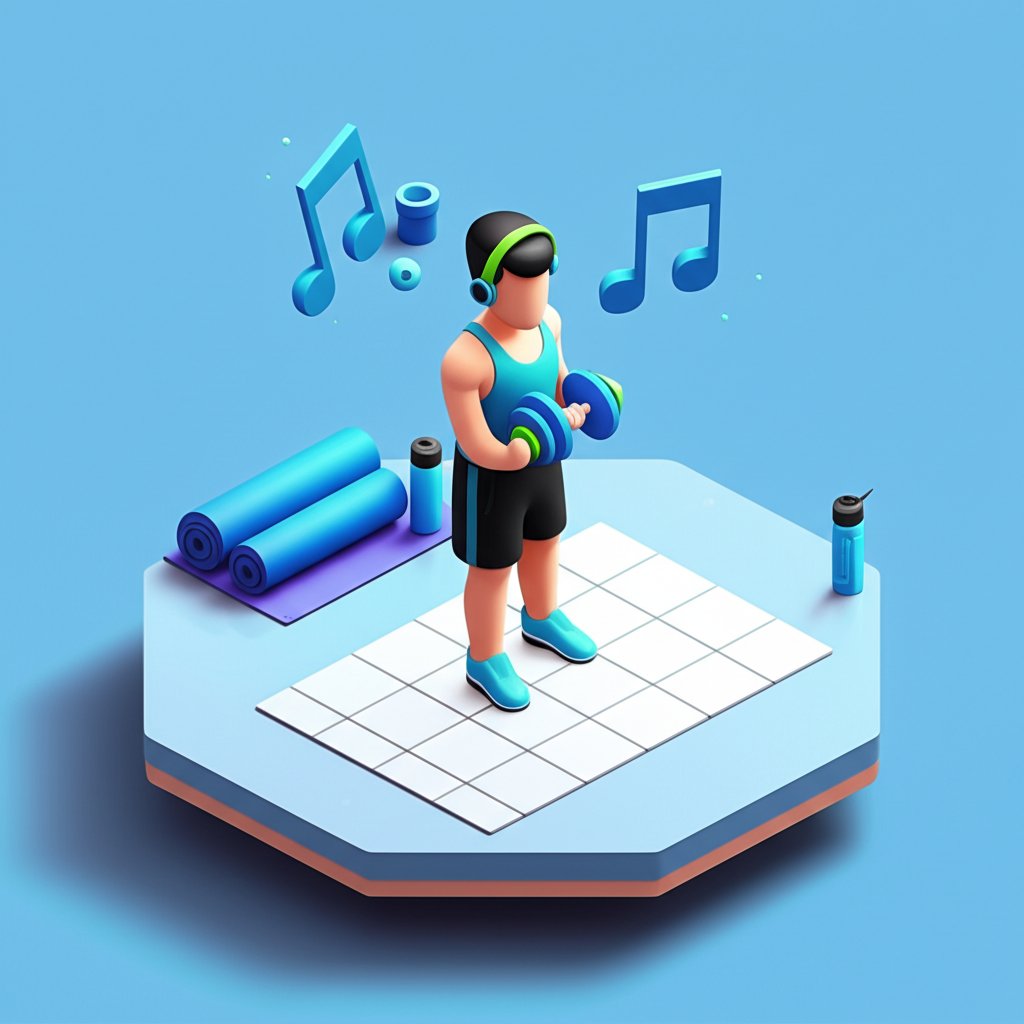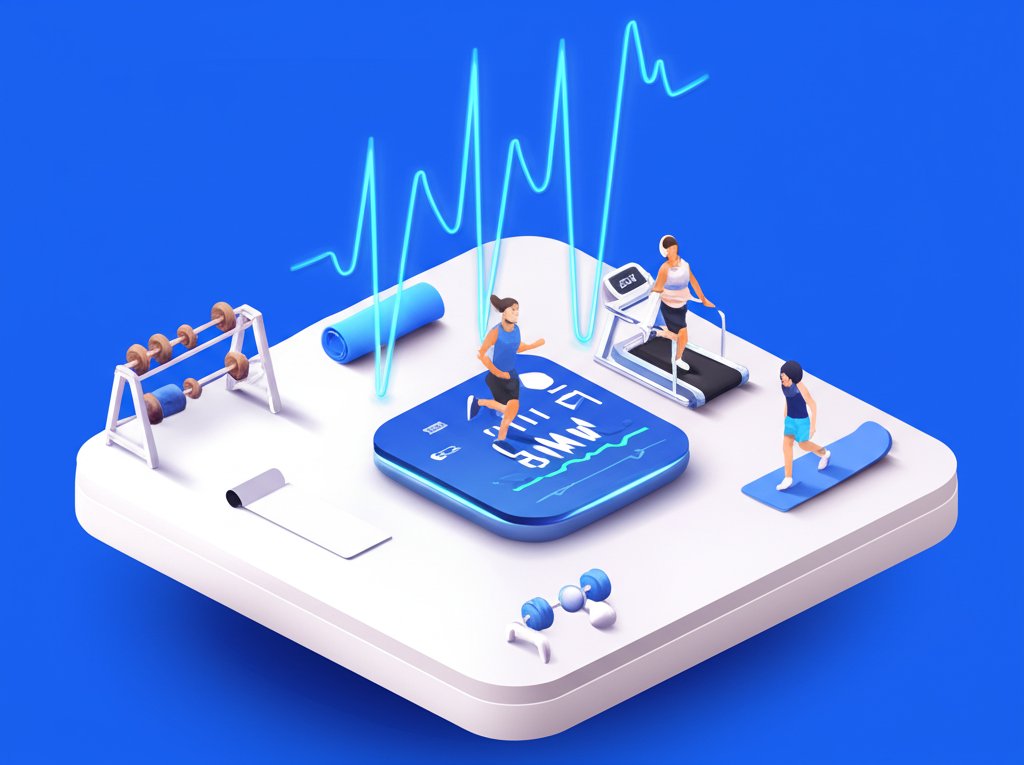
You know that feeling when the alarm blares pre-dawn, and the thought of hitting the gym feels like climbing Everest? It's a universal struggle. But what if the secret to transforming that dread into drive was as simple as pressing play? The best music gym experience, whether at home or in a dedicated facility, isn't just background noise—it's a powerful psychological tool. It can be the difference between a sluggish start and a session that leaves you feeling invincible.
Your personal playlist isn't merely a collection of songs; it's a meticulously crafted motivational engine designed to sync with your body and mind, helping you push harder, recover faster, and even enjoy the burn a little more. Let's unlock the science and art of building that perfect sonic fuel.
At a Glance: Powering Your Workouts with Music
- Boost Performance: Music can increase workout efficiency and endurance by up to 15%.
- Tune Your Tempo: Match music BPM (Beats Per Minute) to your workout intensity for optimal results.
- Curate by Mood: Different genres evoke distinct emotions, perfect for various exercise phases.
- Legal Rhythms: Understand why gyms often have specific music choices due to licensing laws.
- Dynamic Playlists: Build versatile lists that adapt to your session, from warm-up to cool-down.
- Personalization is Key: Your ideal playlist is unique to your tastes and workout goals.
Why Music Matters: Fueling Your Morning Grind

Think about your last workout. Was there music? Studies consistently show that music significantly enhances the exercise experience. It's not just about distraction; it's about a deep psychological and physiological connection. Upbeat tracks can elevate your mood, reduce the perceived exertion of a tough set, and even improve metabolic efficiency, meaning you feel less tired and perform better. Data suggests music can boost workout performance by up to 15%, with a staggering 70% of gym-goers reporting increased energy and focus when training with tunes. This isn't just anecdotal; it's a measurable advantage.
For anyone trying to embrace those early morning gym sessions, this sonic boost is invaluable. It’s an immediate mood shifter, a psychological trigger that helps override the siren call of your warm bed. For more expert advice on kicking off your day right and getting out the door consistently, check out our guide on Morning gym motivation tips. Now, let's dive into how to harness this power directly in your earbuds.
The Science of Sound: Matching BPM to Your Workout Intensity

The tempo of your music, measured in Beats Per Minute (BPM), is a critical factor in maximizing your workout. It acts as a natural metronome for your body, guiding your pace and effort. A slow, steady beat might be perfect for stretching, while a rapid, pounding rhythm can propel you through a sprint. Using the right BPM isn't just about feeling good; it's about optimizing your performance and preventing overexertion or under-stimulation.
Here’s a general guide to help you select tracks with the ideal BPM for different phases of your gym routine:
| Workout Type | Recommended BPM Range | Example Genres/Feeling |
|---|---|---|
| Warm-up | 100-120 BPM | Light Pop, Upbeat Indie, Mellow EDM. Getting moving. |
| Cardio | 120-140 BPM | High-Energy Pop, Dance, Hip-Hop, Fast Rock. Sustained effort. |
| Strength Training | 80-100 BPM | Heavy Hip-Hop, Hard Rock, EDM Drops. Power and focus. |
| Yoga / Pilates | 60-80 BPM | Ambient, Acoustic, Instrumental, Lo-Fi. Calm and flow. |
| HIIT (High-Intensity) | 140-160 BPM | Intense EDM, Dubstep, Punk Rock, Fast Hip-Hop. Max effort bursts. |
| CrossFit | 140-180+ BPM | Aggressive Rock, Metal, Hardcore EDM. Relentless drive. |
| Zumba / Dance Fitness | 130-170 BPM | Latin Pop, Dance, Reggaeton, Afrobeats. Rhythmic and fun. |
| Weightlifting (Heavy) | 130-150 BPM | Intense Rap, Hard Rock Riffs, Power Metal. Peak exertion. |
| Cool-down | 60-90 BPM | Ambient, Chill Pop, Classical, Acoustic. Relax and recover. |
| Practical Tip: Many music apps and websites allow you to filter or discover music by BPM. Use tools like "SongBPM" or integrated features in Spotify or Apple Music to find songs that fit your desired intensity. Even if you can't find exact BPMs, trust your ears: does the beat naturally make you want to move at the right pace? |
Genre Guide: What Music Gets You Moving?
Beyond BPM, the genre of music plays a huge role in dictating your mood and energy. Certain genres are inherently more motivating for workouts due to their rhythmic structure, lyrical content, or overall vibe. Experiment to find what resonates with you, but here are some go-to genres often cited for their workout efficacy:
- Electronic Dance Music (EDM): Think pulsing beats, driving baselines, and euphoric drops. EDM genres like House, Trance, and Dubstep are fantastic for steady-state cardio or pushing through high-intensity intervals. Artists like Avicii, Daft Punk, or Tiesto are common mainstays.
- Hip-Hop: With its strong rhythmic foundation and often aggressive or empowering lyrics, Hip-Hop is a powerhouse for strength training and high-energy cardio. Artists such as Eminem, Jay-Z, Kendrick Lamar, or Cardi B provide tracks that demand attention and drive.
- Rock: From classic anthems to modern metal, rock music offers raw energy and powerful guitar riffs that can ignite intensity. It's excellent for lifting heavy or pushing through a tough cardio session. Think AC/DC, Linkin Park, or Foo Fighters.
- Pop: Often catchy and with universal appeal, pop music is perfect for maintaining a good mood and a steady pace. Tracks from artists like Dua Lipa, Katy Perry, or Taylor Swift can make workouts feel lighter and more enjoyable.
- Reggaeton: The infectious, danceable rhythms of Reggaeton (and Latin Pop generally) are perfect for energetic cardio, Zumba, or any workout where you want to keep the energy high and spirits bright. J Balvin, Bad Bunny, and Daddy Yankee are popular choices.
- Funk: Groovy basslines and upbeat rhythms make funk an excellent choice for a feel-good, rhythmic workout, especially good for getting into a flow state. Think Earth, Wind & Fire or Bruno Mars.
Case Snippet: Sarah, an avid runner, found her long-distance pace improved significantly when she switched from generic pop to a curated playlist of upbeat Trance and Drum & Bass tracks (130-150 BPM). The driving, continuous rhythms helped her maintain a consistent pace and mental focus, reducing her perception of fatigue during mile six.
Curating Your Killer Gym Playlist: A Step-by-Step Guide
Building the ultimate best music gym playlist isn't just about throwing your favorite songs together. It's about strategic sequencing and thoughtful selection.
Step 1: Define Your Workout Structure
Before you pick a single song, map out your workout.
- How long is your warm-up?
- What's your main activity (e.g., strength, cardio, HIIT, yoga)?
- How many sets or intervals?
- How long is your cool-down?
This framework will help you organize your music into distinct segments.
Step 2: Build by Phases (The "Workout Arc")
Create mini-playlists for each phase of your workout, paying close attention to BPM and genre.
- Phase 1: Warm-up (100-120 BPM): Start with something that gently builds energy. Avoid anything too jarring. Example: "Walking on Sunshine" (Katrina & The Waves), "Happy" (Pharrell Williams).
- Phase 2: Main Session - Build-up (120-140 BPM): As you get into your groove, elevate the energy. Example: "Blinding Lights" (The Weeknd), "Don't Start Now" (Dua Lipa).
- Phase 3: Main Session - Peak Performance (140-180+ BPM): For your most intense efforts (heavy lifts, sprints, HIIT), unleash the heavy hitters. These are your "power anthems." Example: "'Till I Collapse" (Eminem), "Enter Sandman" (Metallica), "Levels" (Avicii).
- Phase 4: Main Session - Endurance/Steady State (120-140 BPM): If your workout involves sustained effort, maintain a consistent, motivating beat. Example: "Shape of You" (Ed Sheeran), "Cheap Thrills" (Sia).
- Phase 5: Cool-down (60-90 BPM): Transition to calming, reflective tracks to bring your heart rate down and signal recovery. Example: "Weightless" (Marconi Union), acoustic covers, or instrumental pieces.
Step 3: Mix It Up, But Keep It Cohesive
While you want variety, a drastic genre shift mid-set can be jarring. Try to group similar genres or energy levels within each phase. For example, if your peak performance phase is all rock, keep it rock. If it's EDM, stick with EDM.
Step 4: Test, Tweak, and Personalize
Your first draft won't be perfect. Test your playlist during your actual workouts.
- Did a song come on at the wrong moment?
- Did a track suck the energy out of a peak moment?
- Did you feel bored at any point?
Adjust as needed. Your tastes will evolve, and so should your playlist. Regularly refresh a few songs to keep it exciting.
Step 5: Leverage Curated Playlists (as a starting point)
Platforms like Spotify and YouTube are goldmines for pre-curated workout playlists (e.g., "Hip-Hop Workout Bangers," "Rock Workout," "EDM Cardio"). Use these as inspiration or a base, then customize them with your personal favorites. This saves time on initial song discovery.
Beyond Your Headphones: What Makes a Gym's Music Sound Great?
While this article focuses on your personal playlists, it's worth understanding what goes into a truly best music gym environment. When a gym's overall soundscape feels right, it's usually not accidental. They often employ specific strategies:
- Zoned Music: Different areas of the gym might have different music—upbeat pop in the cardio zone, heavier rock in the weightlifting area, and calming acoustic tunes in a stretching or yoga space. This caters to diverse workout needs.
- Dynamic Playlists: Some gyms use services that adjust music throughout the day, playing more energetic tracks during peak hours and more relaxed tunes during slower periods.
- Member Engagement: The best gyms often solicit feedback, allow song requests, or even host "themed music days" to involve members in the musical selection. This fosters a sense of community and ensures the music resonates with the audience.
- Professional Licensing: Unlike your personal headphones, gyms playing music publicly must adhere to copyright laws. They acquire public performance licenses from organizations like ASCAP, BMI, and SESAC to legally play music. This is why you often hear "radio edits" or why some gyms use background music services designed specifically for businesses, rather than consumer Spotify accounts. This legal requirement often influences their music selection, ensuring a consistent, well-curated, and legally compliant experience for everyone.
Understanding these aspects helps you appreciate the effort behind a good gym's atmosphere and can even inspire how you structure your own dynamic and engaging personal playlists.
Quick Answers: Common Music & Gym Questions
Q: Can listening to music too loudly damage my hearing?
A: Yes. Prolonged exposure to loud music (above 85 decibels) can cause hearing damage. Keep the volume at a comfortable level where you can still hear some ambient sounds, and consider noise-canceling headphones instead of just turning up the volume.
Q: Should I always listen to fast-paced music?
A: Not necessarily. While fast-paced music is great for high-intensity efforts, varying your music to match the phase of your workout (warm-up, strength, cool-down) is more effective. Slow, heavy beats are often better for strength training, for instance.
Q: Does specific music genre actually matter, or is it just personal preference?
A: While personal preference is huge for motivation, studies show certain characteristics common in genres (like strong rhythmic beats, driving baselines, and consistent tempos) are more physiologically effective for elevating mood and performance, regardless of individual preference. The key is to find genres you enjoy that also possess these effective characteristics.
Q: What if I get bored with my playlist quickly?
A: Regularly rotate your playlist! Dedicate 10-15 minutes once a week to add new songs, remove old ones, or discover new artists in your preferred workout genres. Curated playlists on streaming services can be a great source for fresh tracks.
Your Personal Sound Architect: Building Better Gym Sessions
Building the best music gym experience for yourself is an ongoing, rewarding process. It's about becoming your own DJ, your own motivation specialist. Start by dissecting your current workout routine into distinct phases, then align your music's BPM and genre to each of those segments. Don't be afraid to experiment, swap tracks, and embrace new artists.
Your morning gym motivation, and indeed your overall workout quality, can be profoundly impacted by the soundtrack you choose. So, next time you lace up your shoes, remember to queue up not just any playlist, but your perfectly engineered, peak-performance sonic fuel. Press play, and conquer your day.